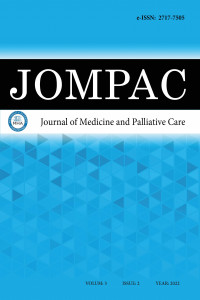Öz
Munchausen syndrome (MS) is a condition in which a patient deliberately mimics signs and symptoms of health problems to gain attention from their close circle and healthcare professionals. Symptoms can be self-induced or fabricated. The paper aimed to discuss MS detected in an adolescent girl who presented with hematological findings and shift the interest to factitious disorders that may be confronted in pediatric practice. A thirteen-year-old girl was admitted to the pediatric hematology outpatient clinic with bruises spread throughout the body, predominantly localized on the arms, persisting for three months and disappearing every two weeks. She had complaints of fatigue and loss of appetite, emerging simultaneously with the occurrence of bruises. Following elaborative examinations, we discovered that the patient was painting bruises on her skin using an eye shadow. MS needs to be considered in differential diagnoses among patients with long-term, inconsistent, and irrational complaints, no underlying causes, and normal laboratory findings. Overall, we presented the case to underline that MS is likely to be confronted in pediatric practice.
Anahtar Kelimeler
Kaynakça
- Tatu L, Aybek S, Bogousslavsky J. Munchausen syndrome and the Wide Spectrum of Factitious Disorders. Front Neurol Neurosci 2018; 42: 81-6.
- Abeln B, Love R. An Overview of Munchausen syndrome and Munchausen Syndrome by Proxy. Nurs Clin North Am 2018 Sep; 53: 375-84.
- Plassman R. The biography of the factitious-disorder patient. Psychother Psychosom 1994; 62: 27-9.
- Jaghab K, Skodnek KB, Padder TA. Munchausen’s syndrome and other factitious disorders in children: case series and literature review. Psychiatry (Edgmont) 2006; 3: 46–55.
- Carney M, Brown J. Clinical features and motives among 42 artificial illness patients. Br J Med Psychol 1983; 56: 57-66.
- Libow JA. Child and adolescent illness falsification. Pediatrics 2000; 105: 336-42.
- Meadow R. Munchausen syndrome by proxy. Arch Dis Child 1982; 57: 92-8.
- Sheehy TW. Case report: factitious hypoglycemia in diabetic patients. Am J Med Sci 1992; 304: 298-302.
- Tatu L, Aybek S, Bogousslavsky J. Munchausen Syndrome and the Wide Spectrum of Factitious Disorders. Front Neurol Neurosci 2018; 42: 81-6.
- Carnahan KT, Jha A. Factitious Disorder. In: StatPearls. Treasure Island (FL): StatPearls Publishing; January 4, 2022.
Öz
Munchausen sendromu (MS), çevresinden ve sağlık görevlilerinden ilgi görmek adına kasıtlı olarak hastalık belirti ve semptomlarını taklit etmesidir. Semptomlar kendi kendine indüklenebilir veya uydurulabilir. Yazımızda hematolojik bulgularla başvuran ergen bir kız çocuğunda saptanan Munchausen sendromunu tartışarak pediatri pratiğinde karşılaşılabilecek yapay bozukluklara dikkat çekmeyi amaçladık. On üç yaşındaki kız hasta, çocuk hematoloji polikliniğine 3 aydır devam eden ortaya çıktığında 2 haftada kaybolan ekimoz şikayeti ile başvurdu. Bu bulgunun eşliğinde halsizlik ve iştahsızlık şikayetleri de mevcuttu. Yapılan tıbbi inceleme ve alınan ayrıntılı öyküden hastanın göz farı ile cildinde ekimozlar çizdiği belirlendi. Tutarsız ve mantıksız şikayet ve bulgular ile başvuran hastalarda , altta yatan herhangi bir patolojik neden yoksa Munchausen sendromu ayırıcı tanıda mutlaka düşünülmelidir. Bu vaka, pediatrik pratikte de Munchausen sendromuyla karşılaşılabileceğine dikkat çekmek için için paylaşılmıştır.
Anahtar Kelimeler
Kaynakça
- Tatu L, Aybek S, Bogousslavsky J. Munchausen syndrome and the Wide Spectrum of Factitious Disorders. Front Neurol Neurosci 2018; 42: 81-6.
- Abeln B, Love R. An Overview of Munchausen syndrome and Munchausen Syndrome by Proxy. Nurs Clin North Am 2018 Sep; 53: 375-84.
- Plassman R. The biography of the factitious-disorder patient. Psychother Psychosom 1994; 62: 27-9.
- Jaghab K, Skodnek KB, Padder TA. Munchausen’s syndrome and other factitious disorders in children: case series and literature review. Psychiatry (Edgmont) 2006; 3: 46–55.
- Carney M, Brown J. Clinical features and motives among 42 artificial illness patients. Br J Med Psychol 1983; 56: 57-66.
- Libow JA. Child and adolescent illness falsification. Pediatrics 2000; 105: 336-42.
- Meadow R. Munchausen syndrome by proxy. Arch Dis Child 1982; 57: 92-8.
- Sheehy TW. Case report: factitious hypoglycemia in diabetic patients. Am J Med Sci 1992; 304: 298-302.
- Tatu L, Aybek S, Bogousslavsky J. Munchausen Syndrome and the Wide Spectrum of Factitious Disorders. Front Neurol Neurosci 2018; 42: 81-6.
- Carnahan KT, Jha A. Factitious Disorder. In: StatPearls. Treasure Island (FL): StatPearls Publishing; January 4, 2022.
Ayrıntılar
| Birincil Dil | İngilizce |
|---|---|
| Konular | Sağlık Kurumları Yönetimi |
| Bölüm | Olgu Sunumu |
| Yazarlar | |
| Yayımlanma Tarihi | 28 Haziran 2022 |
| Yayımlandığı Sayı | Yıl 2022 Cilt: 3 Sayı: 2 |
|
|
|
|
|
|
Dergimiz; TR-Dizin ULAKBİM, ICI World of Journal's, Index Copernicus, Directory of Research Journals Indexing (DRJI), General Impact Factor, Google Scholar, Researchgate, WorldCat (OCLC), CrossRef (DOI), ROAD, ASOS İndeks, Türk Medline İndeks, Eurasian Scientific Journal Index (ESJI) ve Türkiye Atıf Dizini'nde indekslenmektedir.
EBSCO, DOAJ, OAJI, ProQuest dizinlerine müracaat yapılmış olup, değerlendirme aşamasındadır.
Makaleler "Çift-Kör Hakem Değerlendirmesi”nden geçmektedir.
Üniversitelerarası Kurul (ÜAK) Eşdeğerliği: Ulakbim TR Dizin'de olan dergilerde yayımlanan makale [10 PUAN] ve 1a, b, c hariç uluslararası indekslerde (1d) olan dergilerde yayımlanan makale [5 PUAN].
Note: Our journal is not WOS indexed and therefore is not classified as Q.
You can download Council of Higher Education (CoHG) [Yüksek Öğretim Kurumu (YÖK)] Criteria) decisions about predatory/questionable journals and the author's clarification text and journal charge policy from your browser. About predatory/questionable journals and journal charge policy
Not: Dergimiz WOS indeksli değildir ve bu nedenle Q sınıflamasına dahil değildir.
Yağmacı/şüpheli dergilerle ilgili Yüksek Öğretim Kurumu (YÖK) kararları ve yazar açıklama metni ile dergi ücret politikası: Yağmacı/Şaibeli Dergiler ve Dergi Ücret Politikası











